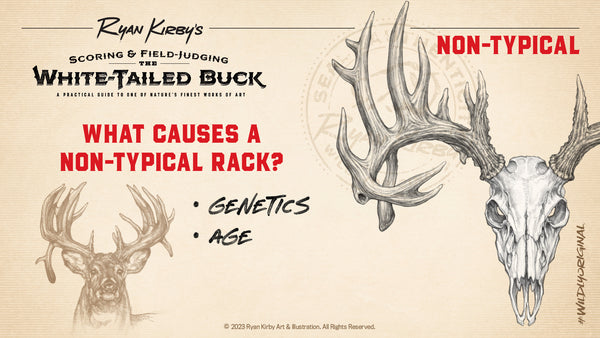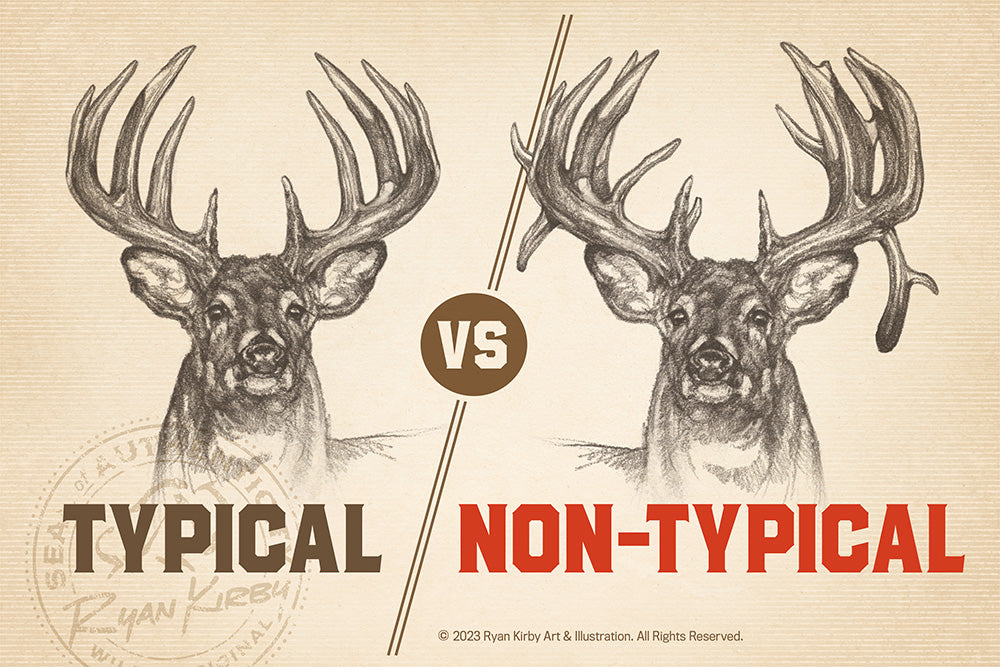Let's look at the difference between Typical and Non-Typical Antlers
For the past year I’ve worked hard to produce the art and information for this new print The Scoring & Field Judging of the White-tailed Buck.
THE TERMS
Before we unpack the specifics, let's understand the terms. A 'typical' rack refers to antlers that follow a standard pattern for the species, with symmetrical tines and evenly spaced points.
On the other hand, a 'non-typical' rack deviates from this usual pattern, resulting in unique and irregular antler growth.
TYPICAL RACK
Let's start by examining the characteristics of a typical rack. In a typical rack, you'll notice symmetrical tines that grow in a linear, organized pattern. These tines usually grow vertically from a horizontal main beam, creating a balanced and visually pleasing arrangement.

Most whitetails in the wild will have a typical rack. This doesn’t mean they won’t have any abnormal points at all, but they won’t have enough to classify them as non-typical.
NON-TYPICAL RACK
Now, let's shift our focus to the non-typical rack. These racks often defy the norm, showcasing irregular and unexpected antler growth. You might see extra tines, points growing in unusual directions, or even an extra main beam.

Non-typicals are much less common, but they get far more attention because of their rarity and potential for truly giant proportions.
Why does a deer grow a non-typical rack? There are three main factors that can cause this:
- Genetics: Both the mother and the father contribute equally to a buck’s genetics, and research has shown that antler characteristics are passed to their offspring. Genetics can determine the shape and size of the antler, but these antlers still require time and nutrition for their size to be fully expressed.
- Time: Like most things in life, antlers get better with age. Most Boone & Crockett entries are from bucks at least 5.5 years old
- Nutrition: The better the habitat, the bigger the antlers. As a general rule, protein and energy rich forage contributes the most to antler growth.

SCORING YOUR RACK
When it comes to scoring, both typical and non-typical racks have their own categories in the record books. Their frames are scored similarly, but non-typicals will have their abnormal points added to their score - resulting in some truly giant deer. You can check out or other video on scoring your deer for more on that.
CONCLUSION
There you have it – a comparison between typical and non-typical whitetail buck racks. Each type has its own allure and anticipation, adding even more depth to our experiences as deer hunters.
Remember, hunting isn't just about the trophy; it's about appreciating time spent outdoors pursing what you love and valuable time with your friends and family. I hope you found the art in information helpful on what separates a typical rack to a nontypical rack.
As an artist, it’s my passion to enhance the atmosphere of deer camp. The best way I know to do that is through my best-selling paper prints “The Growth & Maturity of the White-tailed Buck", “The Anatomy & Physiology of the White-tailed Buck” and The Scoring & Field Judging of the White-tailed Buck.The above art and information (plus much, much more) can be found in one place that you can hang on the wall. It’s been an honor to produce them, and I guarantee you they’ll be the talk of hunt camp!
Wishing you a successful deer season,



